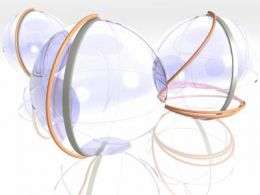To Make Better MRI Images, Let The Atoms Spin Out Of Control

Researchers in Ohio and France have solved a longstanding scientific mystery involving magnetic resonance -- the physical phenomenon that allows MRI instruments in modern hospitals to image tissues deep within the human body. Their discovery, a new mathematical algorithm, should lead to new MRI techniques with more informative and sharper images.
As described in an article posted online today in the Journal of Chemical Physics, a peer-reviewed journal published by the American Institute of Physics (AIP), the work may even help scientists devise ways of using MRI without having to put people inside giant magnets -- an advance that could lead to portable and less costly MRIs.
The new work solves a mystery that has persisted for decades, says Philip Grandinetti, a professor of chemistry at The Ohio State University and one of the coauthors of the article. The solution to this mystery came as a result of their work in trying to optimize magnetic resonance pulse sequences. Specifically, they were looking for better ways of doing something known as an "inversion" in a magnetic resonance measurement.
Bathed in the magnetic field, atomic nuclei within water and other molecules throughout cells and tissues in a person's body will align themselves in the direction of the magnetic field. Inversion is an important process done in MRI scans that realigns the nuclei so they are against the magnetic field. When all is said and done, inverting the nuclei of people inside MRI scanners can reveal such things as cancer tumors, whose slightly different response to the changing field can be used to detect their presence amid surrounding healthy tissue.
These inversions of the nuclear spins are typically done "adiabatically". The method involves placing a patient inside the large donut-shaped magnet of an MRI instrument and applying low-power radio waves that sweep through a specific range of frequencies. If a frequency sweep is performed slowly enough then at the end of the process all the nuclei will be "inverted." The confounding thing, says Grandinetti, is that for decades adiabatic sweeps worked in many situations, even though the mathematics predicted that they should not have. Solving this mystery, Grandinetti and his colleagues turned to a new mathematical framework, called "superadiabaticity" that was discovered in the late 1980s by Michael Berry, a mathematical physicist at University of Bristol, but largely unappreciated until now.
The difference between the two processes is represented in the equations, and the upshot, says Grandinetti, is that now scientists have the correct mathematical framework to work with. This can help them design ways to better control MRI inversions and get more information out of MRI scans.
"We were just viewing the problem wrongly," says Grandinetti, who conducted the research in collaboration with his colleagues Michael Deschamps and Dominique Massiot at the National Center for Scientific Research (CNRS) in France and Gwendal Kervern, Guido Pintacuda, and Lyndon Emsley the University of Lyon in France.
"It is exciting because everyone missed this simple explanation," adds Grandinetti.
Grandinetti hopes to incorporate the algorithm into software for controlling MRI scans, where it would boost image resolution. One day, it might even help these instruments obtain signals from objects located outside of a magnet. Scientists, he adds, could also use superadiabaticity to exert better control over atoms for quantum computing, and to make more precise structural studies of complex biological molecules.
The article "Superadiabaticity in Magnetic Resonance" by Michael Deschamps et al. is being published online on November 25, 2008 in the Journal of Chemical Physics (Volume 129, issue 20). jcp.aip.org/
Source: American Institute of Physics




















